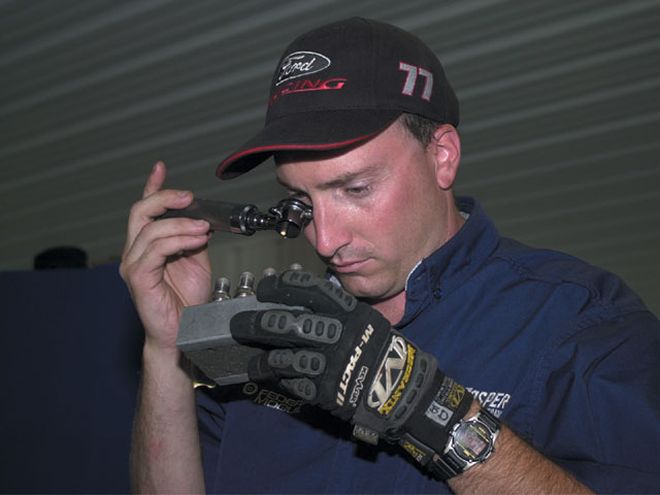
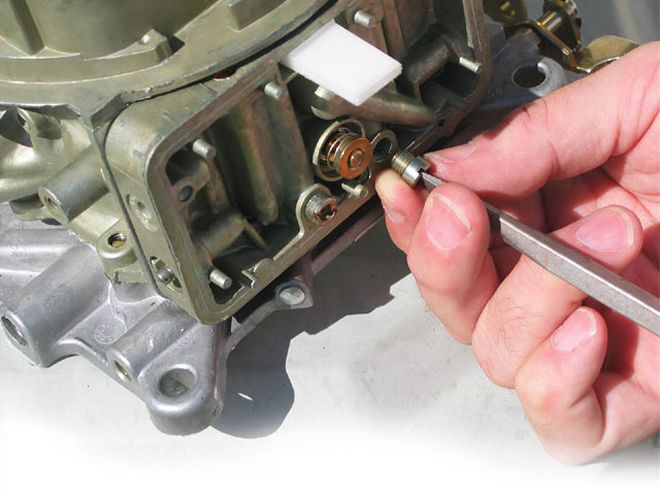 Changing the jets is a simple process. Changing them to get better performance in your engine involves making educated moves based on complete information. Photo by Carolyn Woodard
Changing the jets is a simple process. Changing them to get better performance in your engine involves making educated moves based on complete information. Photo by Carolyn Woodard
Jetting a carburetor is one of the few "black arts" in the automotive world that is still a mystery to most racers and tuners. Most tuners still look at the spark plug, the exhaust port, and the first 6 inches of the header for proper color and make a guess at what jet size change is needed. One of the disadvantages of this method is that the header and spark plug can only indicate what the mixture was at the rpm and load condition at the time. A more scientific or modern method of checking the air/fuel mixture is the use of an infrared exhaust gas analyzer and/or an extended range oxygen sensor in the exhaust system. With this method, the fuel mixture can be "seen" at any rpm and load condition you wish to check. The content of the engine's exhaust can show the air/fuel mixture and how efficiently the engine is burning the fuel.
The proper tuning of a race engine can make the difference between being the winner and dealing with never-ending hassles, trying to keep up with the competition. For most racers, one of the biggest mysteries is jetting the engine in order to obtain the correct air/fuel ratio necessary for your race engine to supply drivable horsepower under all race load demands and while cruising during caution laps. Having the correct air/fuel mixture for the engine's needs while cruising at caution speeds is often ignored. If the air/fuel mixture is too rich for the engine while running at caution speeds, the engine may load up and foul the spark plugs. If the air/fuel mixture is too lean, the engine may run hot. Having an air/fuel mixture rich enough for all racing conditions will allow you to get all the horsepower out of the engine while getting as many laps as possible from a tank of fuel without overheating or doing engine damage that would normally result from having an air/fuel mixture too lean.
Achieving this is one of the many tricks it takes to beat the competition to the finish line. This may sound impossible, but new advances in exhaust gas analysis technology have made it possible to "read" and/or record the air/fuel mixture under almost any driving condition. In the past, exhaust gas analyzers have tended to be large and expensive. We have been using one from the PerformanceGas series of infrared exhaust gas analyzers from OTC/SPX. These units are not only compact and portable, but also affordable for a grassroots racer.
 One way to determine correct air/fuel mixture is by reading the spark plugs. Although it is a popular method, it may not provide all the answers. From the CT Archives
One way to determine correct air/fuel mixture is by reading the spark plugs. Although it is a popular method, it may not provide all the answers. From the CT Archives
Most race carburetors sold today have a generic tune-up or jetting unless the carburetor is built for a specific engine package and fuel. Just adding mufflers or performing any header/exhaust system change (such as adding an "H" pipe into the exhaust) can cause the air/fuel mixture to change, making it necessary to rejet the carburetor. A carburetor not built and tuned for a specific engine, exhaust system, and fuel must supply an air/fuel mixture rich enough for a variety of engines. If the carburetor is supplying an air/fuel mixture that is too lean, the engine will run sluggish, overheat, or the lean mixture could cause engine damage. If the carburetor is supplying an air/fuel mixture that is too rich, the engine may tend to load up, foul the spark plugs, run sluggish, and lack power.
The fuel you use (race or pump), the air density (i.e., barometric pressure, air temperature, humidity), compression ratio, camshaft, exhaust system, ignition timing curve, engine condition, fuel pressure, and so on will all affect the carburetor tune-up needed to get the correct fuel mixture for your engine. If the rules require mufflers at one track but not at another, the carburetor tune-up will need to be adjusted for the change in exhaust backpressure.
The first order of business is to get the correct ignition advance curve for the engine and fuel being used. The fuel pressure must be checked to be sure it has the proper system pressure at all engine load conditions. If the fuel pressure drops below the proper pressure, the carburetor's air/fuel mixture will go lean and engine damage may follow. Once the ignition advance curve has been confirmed, many of the problems we see can be traced to a fuel mixture that is incorrect for the engine's needs.
Before checking the air/fuel mixture, ignition timing and advance curve must first be correct. Any distributor, performance replacement, or original equipment, must have the mechanical and vacuum advance curves checked and then tailored to the engine and the fuel being used. (Note: MSD distributors come with a very conservative mechanical advance curve. Bushings and springs are included in the box to get the desired curve.) An incorrect advance curve may cause an engine to lack power, ping, use too much fuel, or cause the engine to overheat. There are two methods we use to check the distributor's advance curve. One way is to put the distributor on a test stand. The second way is by using an advance timing light such as the Black Light series from OTC/SPX Tool Company.
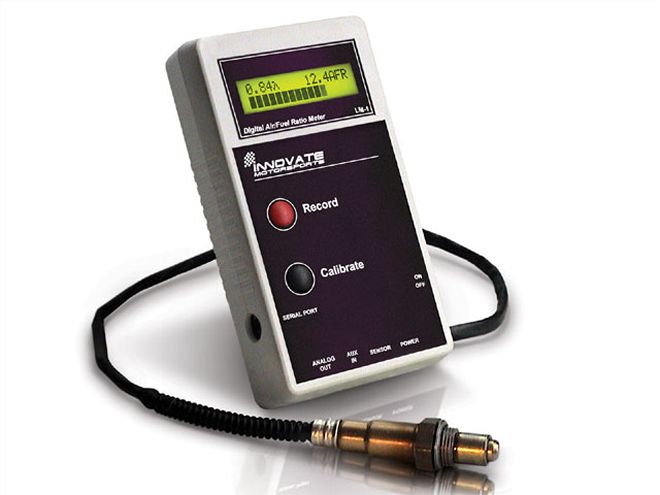 Innovate Motorsports has developed a fully digital air/fuel ratio meter. The LM-1 is able to capture and log up to 44 minutes of AFR data, 12 times per second, in multiple sessions. Courtesy of Innovate Motorsports
Innovate Motorsports has developed a fully digital air/fuel ratio meter. The LM-1 is able to capture and log up to 44 minutes of AFR data, 12 times per second, in multiple sessions. Courtesy of Innovate Motorsports
A lean fuel mixture (too little fuel for the amount of air in the cylinder) can cause an engine to stumble or give a rough idle. It can run too hot, overheat, and cause a lack of power or engine failure. A rich fuel mixture (too much fuel for the amount of air in the cylinder) can cause an engine to "load up" at idle, foul the spark plugs, and also lack power or run sluggish. There are several different methods to determine if the air/fuel mixture is correct. Among them are the following:
1. Read the spark plugs using an illuminated magnifying glass. This method involves looking at the base of the spark plug insulator (white part of the plug) for a slight coloring on the insulator just above where the insulator comes through the steel case. If the mixture is too lean, it will leave no color. A rich mixture causes the fuel ring to become more prominent. Over-rich mixtures give the plug a sooty appearance.
Another way to determine air/fuel mixture is by pulling the header off and looking at the color of the exhaust port in the cylinder head and at the first 6 inches of the exhaust header. However, the header and spark plug color can only show what the air/fuel mixture was at the load condition where you did the check. In the days of leaded fuel and point ignition, this method worked quite well. Today's use of unleaded fuels and high-energy ignition systems has made this method much harder because very little color is seen on the spark plug, making this a job for an expert.
2. Use timed acceleration runs or top speed for the power system. This involves using trial-and-error jetting changes to obtain the best results. Obtaining the correct cruise mixture (which is the air/fuel mixture while the engine drives under light load conditions such as pace laps and yellow flag conditions) is not as easy since it involves jetting the carburetor to get the highest vacuum, then trial and error to get the best engine drivability. When setting the power and cruise mixtures, it's always advisable to stay a little rich in order to avoid engine damage. The idle mixture is set using a tachometer to get the max speed from each idle screw and then go leaner to get a 20-rpm drop. This is known as the lean drop method.
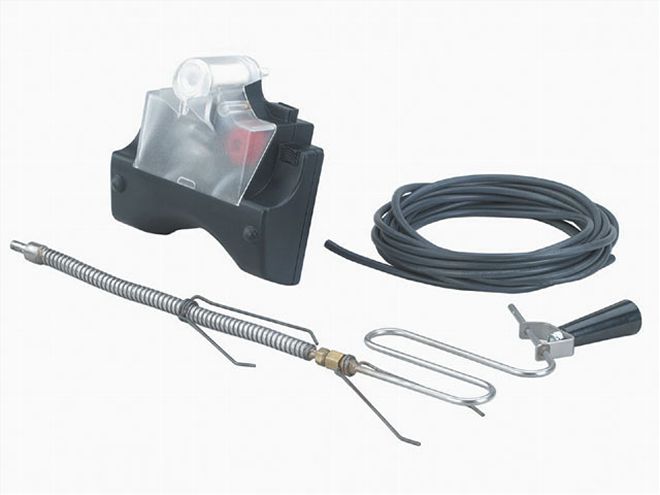 The Performance Exhaust Gas Analyzer can detect the jetting at idle, cruise, or power loads, allowing the tuner to make power determinations for all conditions.
The Performance Exhaust Gas Analyzer can detect the jetting at idle, cruise, or power loads, allowing the tuner to make power determinations for all conditions.
3. The easiest and most accurate method we've found is with the use of an infrared exhaust gas analyzer like the unit we use from OTC/SPX Tool Company called the Perfor- mance Gas Module. This unit allows us to determine what the air/fuel mixture is by "reading" the exhaust gases. By using the Performance Gas unit, the carburetor's jetting (air/fuel mixture) curve can be checked at idle, cruise, or power loads, and then be tailored to what your engine needs to run at its best at all race/driving conditions.
4. An optional method of checking air/fuel mixtures is by using an extended range oxygen sensor installed in the exhaust header. The oxygen sensor is read using a unit referred to as a Lambda meter. This method looks at the unburned combustibles in the engine's exhaust. The unit supplies an air/fuel mixture reading. The readings are very accurate, but false readings can be created by an exhaust leak, engine misfire, or a high overlap camshaft at lower engine rpm. All will cause extra oxygen to be in the exhaust, creating an inaccurate air/fuel mixture reading.
The most accurate and easiest way to check the jetting (air/fuel mixture) of an engine is by observing the carbon monoxide (CO) reading from any infrared gas analyzer, such as the portable unit we are using. To find this value, place the sample probe into the tailpipe, and then the unit will "read" the exhaust and supply the readings necessary to determine the air/fuel mixture. The infrared exhaust gas analyzer and the Lambda meter method allow part throttle fuel mixtures to be checked, which would otherwise be nearly impossible. The readings from either method can be recorded and later played back or looked at in real time at the track or on a dynamometer. It is important to note that any changes other than jet changes and basic adjustments should be performed by a proficient carburetor expert.
After the basic engine condition and tune-up (fuel pressure, timing curve, and so on) are confirmed to be correct and there are no vacuum leaks, the next step is to determine the air/fuel mixture at idle through 3,000 rpm. If the cruise mixture is off, change the jets to get the air/fuel mixture correct at 2,500-3,000 rpm, or cruise range. Next check and set the idle mixture. If the air/fuel mixture is too lean at idle or part throttle and the idle mixture screws do not provide enough adjustment, the correction may involve enlarging the idle jet. If the mixture is still lean at 1,000-1,800 rpm, the idle channel restriction, if used, may have to be slightly enlarged to allow more fuel to be delivered at part throttle.
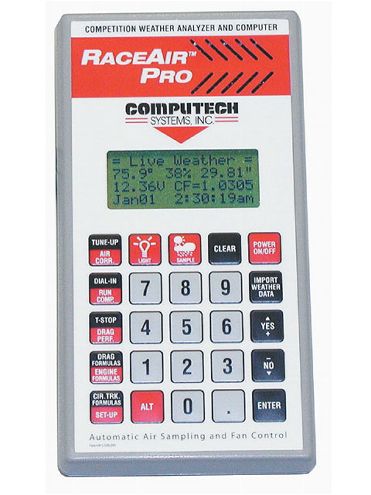 The Race Air Pro weather station will determine conditions and even analyze the information to make suggested jetting changes.
The Race Air Pro weather station will determine conditions and even analyze the information to make suggested jetting changes.
This lean condition at part throttle will cause the engine to miss or stumble, due to the lean air/fuel mixture. This problem is common on many carbs (a notable exception is the Demon line of carburetors, which have used the PerformanceGas to do exhaust gas analysis along with dyno, track, and drivability testing to establish the factory fuel curve that allows for a stumble-free guarantee). If the air/fuel mixture is too rich at idle and part throttle, the idle jet/restriction may be too big and may need to be replaced with a smaller one.
The next step is a track test using a portable infrared exhaust gas analyzer to check the cruise speed air/fuel mixture main jetting, followed by the power air/fuel mixture under load. During a road/track test, you are able to read and correct the jetting in order to have the proper mixtures at idle, cruise/light throttle, and power/wide-open throttle.
A carburetor has an accelerator pump, idle, main jets, and, in most cases, a power system designed to supply the correct air/fuel mixture for the engine's demands. An idle system has an idle jet/restriction that must be changed to supply the desired fuel mixture for idle and off-idle engine demands. For a carburetor that uses a power valve, the main jet size determines what air/fuel mixture is delivered to the engine at light load/cruise speeds (1,500 rpm and up). The power valve restriction (under the power valve) is the determining factor in the air/fuel mixture that the carburetor will supply when the power valve is open; a 6.5-inch power valve will be open and supplying the richer air/fuel mixture needed under high power demands anytime the vacuum is below its 6.5-inch opening point. A carburetor that uses metering rods in the primary jets (such as a Quadrajet) will use the metering rods to change the air-to-fuel ratio for the power and cruise mixture demands of the engine. Remember, the larger the metering rod diameter, the leaner the air/fuel mixture will be.
The accelerator pump adds fuel as the throttle valves are opened. Tuning the accelerator pump squirter volume and duration is mainly trial and error. For a Demon- or Holley-style carburetor, the combination used most often is a 0.031-inch squirter, along with a pink pump cam. We often shim the accelerator pump duration spring to make the pump more active. Many race-designed carburetors have changeable idle and high-speed air bleeds, but I will leave their affect on the fuel curve to be discussed at another time.
Readings provided by exhaust analyzers
* CO (carbon monoxide): We use the reading from an infrared gas analyzer to determine the air/fuel ratio. (Note: CO is partially burned fuel.)
* HC (hydrocarbons): The amount of unburned fuel or an indicator of an engine misfire. The best mixture gives you the lowest HC.
* CO2 (carbon dioxide): The product of complete combustion. The best mixture gives you the highest CO2 reading.
* O2 (oxygen): A high O2 reading indicates a lean mixture or an exhaust leak. (Note: if O2 is above 2-3 percent, CO readings will not be accurate.
The best power and cruise air/fuel mixtures (CO) will burn all the O2 in the cylinder and create the lowest HC reading (misfire). They will also cause the CO2 reading to be its highest.
A starting point for air/fuel mixtures for most race engines is:
Idle: 1-3 percent CO or a 14.1-13.4:1 air/fuel mixture
Cruise rpm: 1-3 percent CO or a 14.2-14.0:1 air/fuel mixture
Power mixture and acceleration: 6.6 percent CO or a 12.0:1 air/fuel mixture for a "normal" engine; a high performance engine with improved combustion chamber design such as a Winston Cup engine, in some cases, may use a slightly leaner power mixture of 4 percent CO or a 13.0:1 air/fuel ratio.
The Lambda meter method uses an extended range oxygen sensor to determine the fuel mixture by analyzing the unburned combustibles in the exhaust gas. An extended range oxygen sensor can read air/fuel mixtures as rich as 10 to 1. On the lean side, it can read air/fuel mixtures of 19 to 1 or leaner (a standard oxygen sensor is only accurate at air/fuel mixtures of around 14.7 to 1). This method has the advantage of extremely fast reaction times for the readings, but it can be less than accurate on an engine with a race cam at other than high load conditions because of the excessive oxygen in the exhaust created by the cam overlap. The use of an infrared exhaust gas analyzer, while slower in reaction time, has the advantages of reading the oxygen/unburned combustibles content of the exhaust and determining the air/fuel mixture by reading CO. The engine's rate of misfire can be determined by reading the HC, and the engine's efficiency can be determined by the CO2 reading.
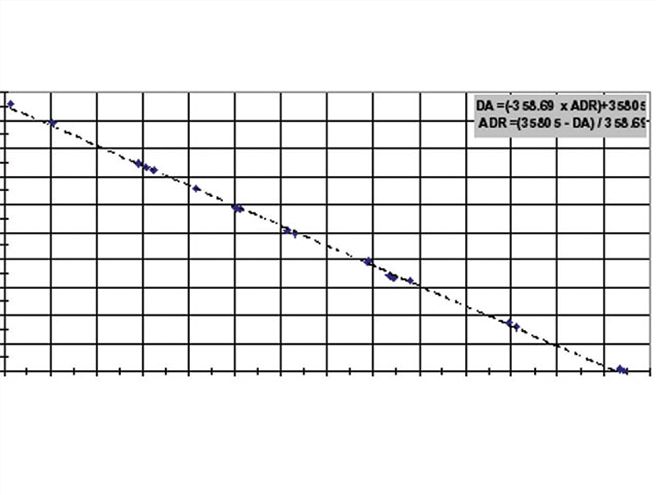 Courtesy of Computech Systems
Courtesy of Computech Systems
When the engine is being used at a racetrack or anytime you are trying to get the very most from the engine, the air/fuel mixtures should be adjusted correctly for the ever-changing air density. First, the baseline tune-up for the air/fuel mixtures must be set and correct for the conditions of testing. The next step is fine-tuning for changes in the air density.
The readings from a barometer as well as air temperature and humidity gauges can be used to calculate the density altitude or the air density ratio (ADR percentage) change from your baseline jetting. Knowing the density altitude and comparing it to what it was when you established your baseline tune-up will tell you which way you should change your fuel curve for the weather conditions. The suggested change in jet size is to go down one jet size for every 1,500 feet in density altitude you go up. Conversely, for every 1,500 feet you go down in density altitude, go up one jet size. A lot of racers use density altitude as a tuning aid, but ADR percentage is more user friendly. ADR percentage is easier to use because of the following: If the air quality goes up 2 percent, the engine fuel must increase 2 percent to keep the same tune-up. The ADR percentage and density altitude are both air quality indicators. ADR is expressed in percent of standard conditions, and density altitude is expressed in feet above the same standard conditions.
The weather station from Computech Systems offers both the RaceAir Competition Weather Analyzer and the RaceAir Pro. The RaceAir Competition Weather Analyzer supplies a reading for the density altitude or the air density ratio. The RaceAir Pro has many additional features, including a program that can supply you with a suggested jet change that would be correct for the current air density. These changes in jet size are necessary because as the density altitude goes up, the air becomes thinner, thus the engine needs less fuel.
By using the density altitude or the ADR percentage to help calculate which jet size to use, it becomes easy to keep up with the ever-changing weather conditions and stay a step ahead of the competition. This information can also be used to determine which jet you should change to when going to a race at a high-altitude racetrack before you even get there.
A properly tuned fuel and ignition system will allow your race engine to perform up to its potential and will supply you a better running, more reliable race car. Using an extended range oxygen sensor combined with an infrared exhaust gas analyzer and then reading the spark plugs is the best way to know if the air/fuel mixture is correct for your engine. Taking the time to properly tune your race engine's fuel system will not only allow you to unlock all its power, it may help avoid destroying an expensive race engine due to an incorrect fuel system tune-up.
Whether you purchase a new or used infrared exhaust gas analyzer or borrow one from another racer, this method of checking and setting the air/fuel mixture can help you get the most out of your engine. For a more detailed explanation of the use of a five-gas infrared exhaust gas analyzer in fuel system diagnosis, see www.automotiveu.com.
Jetting With An Infrared Gas AnalyzerCO-To-Air/Fuel ConversionCOA/FWhen jetting with an infrared exhaust gas analyzer, use this CO-to-air/fuel conversion table for best results.